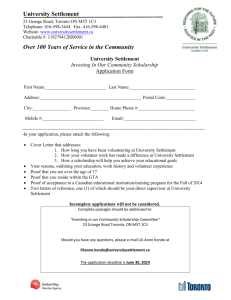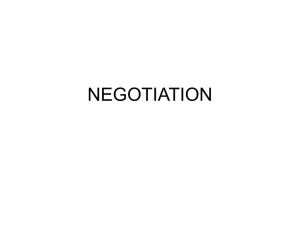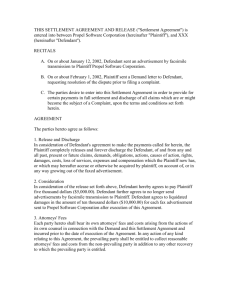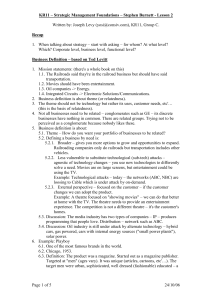Reservation Points: A Perspective on Where the “Real” Negotiation
advertisement
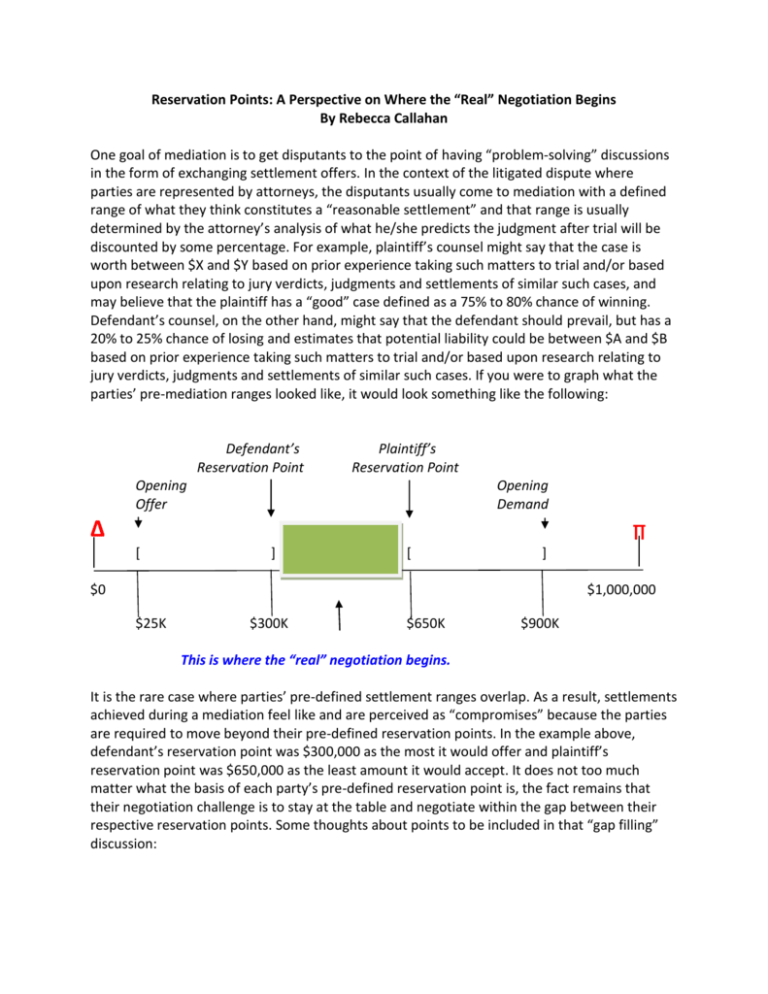
Reservation Points: A Perspective on Where the “Real” Negotiation Begins By Rebecca Callahan One goal of mediation is to get disputants to the point of having “problem-solving” discussions in the form of exchanging settlement offers. In the context of the litigated dispute where parties are represented by attorneys, the disputants usually come to mediation with a defined range of what they think constitutes a “reasonable settlement” and that range is usually determined by the attorney’s analysis of what he/she predicts the judgment after trial will be discounted by some percentage. For example, plaintiff’s counsel might say that the case is worth between $X and $Y based on prior experience taking such matters to trial and/or based upon research relating to jury verdicts, judgments and settlements of similar such cases, and may believe that the plaintiff has a “good” case defined as a 75% to 80% chance of winning. Defendant’s counsel, on the other hand, might say that the defendant should prevail, but has a 20% to 25% chance of losing and estimates that potential liability could be between $A and $B based on prior experience taking such matters to trial and/or based upon research relating to jury verdicts, judgments and settlements of similar such cases. If you were to graph what the parties’ pre-mediation ranges looked like, it would look something like the following: Defendant’s Reservation Point Plaintiff’s Reservation Point Opening Offer Opening Demand ∆ ∏ [ ] [ ] $0 $1,000,000 $25K $300K $650K $900K This is where the “real” negotiation begins. It is the rare case where parties’ pre-defined settlement ranges overlap. As a result, settlements achieved during a mediation feel like and are perceived as “compromises” because the parties are required to move beyond their pre-defined reservation points. In the example above, defendant’s reservation point was $300,000 as the most it would offer and plaintiff’s reservation point was $650,000 as the least amount it would accept. It does not too much matter what the basis of each party’s pre-defined reservation point is, the fact remains that their negotiation challenge is to stay at the table and negotiate within the gap between their respective reservation points. Some thoughts about points to be included in that “gap filling” discussion: There are numerous procedural hurdles that can be put in the path of both parties in the hopes of eliminating some or all of that party’s claims or defenses, or significantly impairing the presentation of their case. All cases have them! Dispositive contingencies are part of each side’s “worst case” analysis. These contingencies can be identified, evaluated and weighed and consideration given to the risk avoided by settlement. There are sometimes things external to the lawsuit that could affect the value of what is at issue, the finances or stability of one or both parties, etc. These contingencies are frequently the answer to “What could possibly go wrong?” Just like dispositive contingencies, these outside influences can be identified, evaluated and weighed and an adjustment made for the risk avoided by settlement. For example, the impact of avoiding fluctuations in the stock, financial or real estate markets; the impact of avoiding negative publicity about the lawsuit and adverse verdict; the impact of removing a contingent liability from a balance sheet. Other factors may be difficult to quantify but nevertheless have bearing upon the rational value of a case for purposes of settlement as compared with possibly obtaining a judgment in the future. For example: What is the judge’s track record with respect to the efficient (or inefficient) management of a trial? Does the judge have a known predisposition with respect to summary judgment, jury voir dire, motions in limine, foundational issues, use of scientific information? Has the judge decided similar issues in other cases and, if so, which way did he/she rule? What is the experience or skill level of the attorney(s) on the other side? What is the population from which a jury will be pulled and what biases or prejudices might they, as a group, share in terms of how they might view / identify with or against the parties. And finally, the complete unknown as to who your jurors might be and the complete lack of control over what they do and how they decide a case. All of the foregoing are risk factors. When a risk is avoided through settlement, an is appropriate. The above discussion points all focus on quantifying the value of risk avoided. We do not perceive or assess risk the same way, and much depends on whether we are facing a gain (selling) or a loss (buying). Generally speaking, in the context of a litigated dispute, plaintiff is selling its claim and defendant is buying plaintiff’s claim. Studies show that the person selling places a higher value on that which is being sold than the person buying. Additionally, some people are more risk averse than others – meaning that they will pay more or take less in order to avoid the risk of loss/liability – and some people are risk seekers in the sense that what looks like an unwise gamble to most would look like a gamble worth taking to the person with an exceptionally high tolerance for risk. Risk attitudes of both the parties and their counsel are a 2 subliminal factor in any negotiation and exert strong cognitive influence on how settlement is viewed as compared to the high stakes and uncertainty associated with litigation. Consider the recent decision in the Playboy whistle blower case brought by former senior vice president, Catherine Zulfer. In May 2015, Ms. Zulfer received a $6 million jury verdict under a 2002 federal law that protects whistleblowers. On top of that, the court awarded punitive damages. Playboy was represented by Sheppard Mullin, whom it sued for legal malpractice claiming that an attorney of ordinary skill and capacity would have advised it to settle the case and to demand that its insurer tender the $5 million policy limits. However, according to news reports, Sheppard Mullin very carefully evaluated the case, conducted research and analysis of prior verdicts and settlements, and even conducted a mock jury trial before providing Playboy with a valuation of the case. Based upon the information collected through these activities, Sheppard Mullin evaluated Playboy’s “worst case” scenario as presenting an exposure well below policy limits and rated Playboy as having a 75% chance of prevailing on Ms. Zulfer’s wrongful termination claim. What Playboy appears to have not factored in was the 25% chance of not prevailing, and the caution Sheppard Mullin most certainly gave its client that juries are unpredictable, especially with respect to their handling of emotional distress and punitive damages – both of which were awarded in this case. There are no reports of what was or was not offered or demanded in any pretrial negotiations between the parties, but it is probably safe to assume that Ms. Zulfer’s opening demand was above policy limits and that Playboy’s final offer was well below the $5 million policy. Calling attention to the Playboy case is not intended to be critical of Playboy or its counsel 1 but, rather, to call attention to how much influence a defined reservation point may have on a party’s perception and/or understanding of its downside risk and how that may in turn influence the party’s attitude about and approach to settlement. It also shows the importance of reassessing the value of a case for purposes of settlement once the gap between the parties’ respective reservation points has been reached – the assumption being that a settlement was attempted in the Playboy case and the parties got stuck around the policy limits figure (with Ms. Zulfer at or above policy limits and Playboy well below). Finally, it illustrates the importance of managing a client’s expectations, and interjecting that management oversight periodically as the case develops. When the reservation-point-gap is reached, the question at that point is not so much “Is this a good deal on the table that I should accept?” but “Will I regret not staying at the table and making a further effort to settle if the worst case turns out to be worse than estimated?” This is a very uncomfortable discussion to be had, for sure, but it is equally uncomfortable all around the table! Movement in this zone is both difficult and uncomfortable. However, in this changing climate where attorneys are being sued for “settlement malpractice” – both for recommending 1 To the contrary, based on what has been reported concerning counsel’s efforts to assess Playboy’s potential exposure, it would appear that they appropriately told the client that there was risk and that they made a concerted effort to approximate the client’s worst case based on the information then available in terms of prior judgments and verdicts. 3 or not recommending settlement – it is a discussion that needs to be had. This is especially true since a foundational underpinning of mediation is party self-determination, meaning that it is the party (not the attorney) who should to make the ultimate decision to or not to accept a settlement and thus take ownership of that decision. 4




